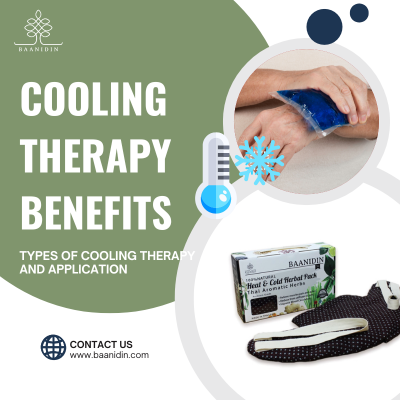การรักษาตนเองด้วยความเย็น
1358 Views |

การบำบัดด้วยความเย็นหรือที่เรียกว่าการรักษาด้วยความเย็น (Cryotherapy) เกี่ยวข้องกับการใช้อุณหภูมิเย็นๆ กับร่างกายเพื่อวัตถุประสงค์ในการรักษาโรค การบำบัดนี้สามารถจัดการได้ในรูปแบบต่างๆ รวมถึงแผ่นประคบสมุนไพร ถุงน้ำแข็ง สเปรย์น้ำ อาบน้ำแข็ง และห้องเย็น ประโยชน์ของการบำบัดด้วยความเย็นนั้นมีมากมายและอาจส่งผลต่อร่างกายในด้านบวกหลายประการ:
ลดการอักเสบ:ประโยชน์ที่สำคัญที่สุดประการหนึ่งของการบำบัดด้วยความเย็นคือความสามารถในการลดการอักเสบและบวม โดยเฉพาะหลังจากได้รับบาดเจ็บ อุณหภูมิที่เย็นจะบีบรัดหลอดเลือด ซึ่งสามารถลดการไหลเวียนของของเหลวเข้าสู่เนื้อเยื่อ จึงช่วยลดอาการบวมและอักเสบได้
การบรรเทาอาการปวด:การบำบัดด้วยความเย็นมีประสิทธิภาพในการทำให้ชาบริเวณที่เจ็บปวด สามารถชะลอการส่งสัญญาณประสาท ซึ่งสามารถลดความรู้สึกเจ็บปวดได้ ซึ่งเป็นประโยชน์อย่างยิ่งสำหรับการบาดเจ็บจากการเล่นกีฬา เคล็ดขัดยอก และปวดกล้ามเนื้อ
ช่วยฟื้นตัวเร็วขึ้น:การลดการอักเสบและความเจ็บปวด การบำบัดด้วยความเย็นสามารถช่วยเร่งกระบวนการฟื้นตัวของร่างกายหลังจากออกกำลังกายอย่างหนักหรือได้รับบาดเจ็บ นักกีฬามักใช้ความเย็นจัดเป็นส่วนหนึ่งของกิจวัตรการฟื้นตัวเพื่อเพิ่มการซ่อมแซมกล้ามเนื้อ
ลดอาการกล้ามเนื้อกระตุก:การบำบัดด้วยความเย็นสามารถช่วยลดอาการกระตุกของกล้ามเนื้อ บรรเทาอาการไม่สบายของกล้ามเนื้อและความเจ็บปวด
ลดกรดแลคติค:หลังจากออกกำลังกายอย่างหนัก การบำบัดด้วยความเย็นสามารถช่วยชำระล้างกรดแลคติคที่สะสมในกล้ามเนื้อ ซึ่งช่วยลดอาการปวดและเพิ่มระยะเวลาในการฟื้นตัวให้เร็วขึ้น
ปรับปรุงการทำงานของข้อต่อ:ด้วยการลดการอักเสบและความเจ็บปวด การบำบัดด้วยความเย็นยังสามารถปรับปรุงการทำงานของข้อต่อ ทำให้เป็นประโยชน์ในการรักษาโรคต่างๆ เช่น โรคข้ออักเสบและความผิดปกติของข้อต่อเรื้อรังอื่นๆ
กระตุ้นระบบภูมิคุ้มกัน:การศึกษาบางชิ้นชี้ให้เห็นว่าการใช้ความเย็นจัดเป็นประจำสามารถกระตุ้นระบบภูมิคุ้มกันโดยการเพิ่มการไหลเวียนของเม็ดเลือดขาว ซึ่งมีบทบาทสำคัญในการต่อสู้กับการติดเชื้อและโรคต่างๆ
สร้างความแข็งแรงให้ผิว:การบำบัดด้วยความเย็นอาจเป็นประโยชน์ต่อสภาพผิวบางอย่างโดยการลดการอักเสบและการระคายเคือง อาการต่างๆ เช่น กลากและโรคสะเก็ดเงินอาจดีขึ้นด้วยการรักษาด้วยความเย็นจัดเป็นประจำ
กระตุ้นระบบประสาท:การสัมผัสกับความเย็นสามารถกระตุ้นระบบประสาท ส่งผลให้มีความตื่นตัวมากขึ้น อารมณ์ดีขึ้น และลดระดับความเครียด นอกจากนี้ยังสามารถส่งผลให้รูปแบบการนอนหลับดีขึ้นและรู้สึกเป็นอยู่ที่ดีอีกด้วย
ช่วยเพิ่มการเผาผลาญ:ผู้เสนอการรักษาด้วยความเย็นจัดบางคนอ้างว่าสามารถเพิ่มการเผาผลาญและช่วยในการลดน้ำหนักได้โดยการบังคับให้ร่างกายทำงานหนักขึ้นเพื่อรักษาอุณหภูมิแกนกลางของมัน อย่างไรก็ตาม จำเป็นต้องมีการวิจัยเพิ่มเติมเพื่อทำความเข้าใจและยืนยันผลประโยชน์นี้อย่างถ่องแท้

การใช้ความเย็นบำบัดอย่างมีประสิทธิภาพและปลอดภัยต้องอาศัยความเข้าใจวิธีการใช้ที่เหมาะสมและช่วงอุณหภูมิที่เหมาะสมสำหรับการรักษา วิธีการและอุณหภูมิอาจแตกต่างกันไปขึ้นอยู่กับสภาวะเฉพาะที่กำลังรับการรักษาและประเภทของการบำบัดด้วยความเย็นที่ใช้
ประเภทของการบำบัดด้วยความเย็นและการประยุกต์
การประคบเย็น
วิธีใช้:ห่อน้ำแข็งหรือประคบเย็นด้วยผ้าบางๆ เพื่อปกป้องผิว ประคบบริเวณที่ได้รับผลกระทบครั้งละ 15-20 นาที
อุณหภูมิ:โดยปกติแล้ว ถุงน้ำแข็งหรือแผ่นประคบที่มีจำหน่ายตามท้องตลาดทั่วๆไป ได้รับการออกแบบให้มีอุณหภูมิประมาณ 0°C (32°F) ซึ่งมีประสิทธิภาพในการลดการอักเสบและอาการปวดชาโดยไม่เสี่ยงต่อการถูกความเย็นกัด
การอาบในอ่างน้ำแข็ง
วิธีใช้:เติมน้ำเย็นและน้ำแข็งลงในอ่าง แช่บริเวณที่มีอาการ (หรือทั่วร่างกายสำหรับนักกีฬา) เป็นเวลา 10-15 นาที
อุณหภูมิ:ตั้งเป้าไว้ที่อุณหภูมิของน้ำระหว่าง 10°C ถึง 15°C (50°F ถึง 59°F) ช่วงนี้มีประสิทธิภาพในการฟื้นฟูกล้ามเนื้อโดยไม่ทำให้เกิดการเปลี่ยนแปลงจากความร้อนหรือภาวะอุณหภูมิร่างกายลดลง
สเปรย์น้ำ
วิธีใช้:ฉีดสเปรย์ลงบนผิวหนังโดยตรงบริเวณที่เจ็บปวดหรือบวมเป็นเวลาไม่กี่วินาที
อุณหภูมิ:สเปรย์จะทำให้ผิวหนังเย็นลงอย่างรวดเร็ว แต่อุณหภูมิที่เฉพาะเจาะจงอาจแตกต่างกันไป ใช้ตามคำแนะนำเพื่อหลีกเลี่ยงอันตรายต่อผิวหนัง
เซสชันไครโอแชมเบอร์/ไครโอบำบัด Cryochambers/Cryotherapy Sessions
วิธีใช้:ยืนในห้องการรักษาด้วยความเย็นจัดในช่วงเวลาสั้นๆ โดยทั่วไปจะอยู่ระหว่าง 2 ถึง 4 นาที ภายใต้การดูแลของผู้เชี่ยวชาญ
อุณหภูมิ:อุณหภูมิห้องเพาะเลี้ยงสามารถอยู่ในช่วงตั้งแต่ -110°C ถึง -140°C (-166°F ถึง -220°F) ความเย็นจัดส่งผลกระทบต่อทั้งร่างกาย กระตุ้นการตอบสนองทางสรีรวิทยา
แนวทางการใช้งานอย่างมีประสิทธิภาพ
ระยะเวลา:สำหรับการประคบเย็น กฎทั่วไปคือประคบเย็นครั้งละ 15-20 นาที สามารถทำซ้ำได้ทุก 1-2 ชั่วโมงตามต้องการในช่วง 48 ชั่วโมงแรกหลังการบาดเจ็บ
ความถี่:การบำบัดด้วยความเย็นในห้องเย็นมักจะจำกัดอยู่เพียงวันละครั้งหรือสองสามครั้งต่อสัปดาห์ ขึ้นอยู่กับความอดทนของแต่ละบุคคลและสภาพที่กำลังรับการรักษา
การป้องกัน:ใช้สิ่งกีดขวาง (เช่น ผ้าหรือผ้าเช็ดตัว) เสมอระหว่างน้ำแข็งหรือแหล่งความเย็นกับผิวหนังเพื่อป้องกันน้ำแข็งกัด
การสังเกต:ติดตามผิวหนังและความรู้สึกระหว่างการรักษา หากผิวหนังชา ซีด หรือเจ็บปวด ให้หยุดการรักษาทันที
การให้คำปรึกษา:สำหรับการบาดเจ็บหรืออาการเฉพาะเจาะจง โปรดปรึกษาผู้ให้บริการด้านสุขภาพเพื่อขอคำแนะนำเกี่ยวกับระยะเวลาและความถี่ของการบำบัดด้วยความเย็น
ข้อควรพิจารณาด้านความปลอดภัย
หลีกเลี่ยงการสัมผัสโดยตรง:ห้ามใช้น้ำแข็งกับผิวหนังโดยตรง เพราะอาจทำให้เกิดอาการบวมเป็นน้ำเหลืองได้
เวลาในการตรวจสอบ:อย่าใช้เกินเวลาที่แนะนำเพื่อหลีกเลี่ยงความเสียหายของเส้นประสาทหรือการบาดเจ็บที่ผิวหนัง
ระมัดระวังเงื่อนไขบางประการ:ผู้ที่มีอาการเช่นปรากฏการณ์ Raynaud, โรคปลายประสาทอักเสบ หรือโรคหลอดเลือดหัวใจ ควรปรึกษาผู้ให้บริการด้านการแพทย์ก่อนใช้การบำบัดด้วยความเย็น
เมื่อปฏิบัติตามแนวทางเหล่านี้ คุณจะสามารถใช้ความเย็นบำบัดได้อย่างมีประสิทธิภาพเพื่อจัดการความเจ็บปวด ลดการอักเสบ และเร่งการฟื้นตัวพร้อมทั้งลดความเสี่ยงของผลข้างเคียง

Cooling therapy, also known as cryotherapy, involves the application of cold temperatures to the body for therapeutic purposes. This treatment can be administered in various forms, including ice packs, coolant sprays, ice baths, and cryochambers. The benefits of cooling therapy are wide-ranging and can affect the body in several positive ways:
Reduces Inflammation: One of the most significant benefits of cooling therapy is its ability to reduce inflammation and swelling, especially after an injury. Cold temperatures constrict blood vessels, which can decrease the flow of fluid into tissues, thereby reducing swelling and inflammation.
Pain Relief: Cooling therapy is effective in numbing painful areas. It can slow down nerve signal transmissions, which can reduce the feeling of pain. This is particularly beneficial for sports injuries, sprains, and muscle pains.
Faster Recovery: By reducing inflammation and pain, cooling therapy can help speed up the body's recovery process after intense physical activity or injury. Athletes often use cryotherapy as part of their recovery routine to enhance muscle repair.
Reduces Muscle Spasms: Cold therapy can help to decrease muscle spasms, providing relief from muscular discomfort and pain.
Decreases Lactic Acid: After intense exercise, cooling therapy can help to flush out lactic acid build-up in muscles, thereby reducing soreness and improving recovery times.
Improves Joint Function: By reducing inflammation and pain, cooling therapy can also improve joint function, making it a useful treatment for conditions like arthritis and other chronic joint disorders.
Enhances Immune Response: Some studies suggest that regular use of cryotherapy can boost the immune system by increasing the circulation of white blood cells, which play a crucial role in fighting off infections and diseases.
Improves Skin Conditions: Cooling therapy can be beneficial for certain skin conditions by reducing inflammation and irritation. Conditions like eczema and psoriasis may see improvement with regular cryotherapy sessions.
Stimulates Nervous System: Exposure to cold can stimulate the nervous system, leading to increased alertness, improved mood, and a reduction in stress levels. This can also result in better sleep patterns and a general feeling of well-being.
Boosts Metabolism: Some proponents of cryotherapy claim that it can boost metabolism and aid in weight loss by forcing the body to work harder to maintain its core temperature. However, more research is needed to fully understand and confirm this benefit.
Types of Cooling Therapy and Application
Ice Packs or Cold Compresses
How to Use: Wrap the ice pack or cold compress in a thin towel to protect the skin. Apply to the affected area for 15-20 minutes at a time.
Temperature: Typically, commercial ice packs are designed to reach temperatures around 0°C (32°F), which is effective for reducing inflammation and numbing pain without risking frostbite.
Ice Baths
How to Use: Fill a tub with cold water and ice cubes. Immerse the affected area (or the whole body, for athletes) for 10-15 minutes.
Temperature: Aim for water temperatures between 10°C to 15°C (50°F to 59°F). This range is effective for muscle recovery without causing thermal shock or hypothermia.
Coolant Sprays
How to Use: Spray directly onto the skin over the painful or swollen area for a few seconds.
Temperature: The spray cools the skin rapidly, but specific temperatures can vary. Use as directed to avoid skin damage.
Cryochambers/Cryotherapy Sessions
How to Use: Stand in a cryotherapy chamber for a short duration, typically between 2 to 4 minutes, under professional supervision.
Temperature: Chamber temperatures can range from -110°C to -140°C (-166°F to -220°F). The extreme cold affects the whole body, stimulating physiological responses.
Guidelines for Effective Use
Duration: For ice packs and cold compresses, a general rule is to apply cold therapy for 15-20 minutes at a time. This can be repeated every 1-2 hours as needed during the first 48 hours after an injury.
Frequency: Cryotherapy sessions in a chamber are usually limited to once per day or a few times a week, based on individual tolerance and the condition being treated.
Protection: Always use a barrier (like a cloth or towel) between the ice or cold source and the skin to prevent frostbite.
Observation: Monitor the skin and sensation during treatment. If the skin becomes numb, pale, or painful, stop the treatment immediately.
Consultation: For specific injuries or conditions, consult with a healthcare provider for recommendations on duration and frequency of cooling therapy.
Safety Considerations
Avoid Direct Contact: Never apply ice directly to the skin, as it can cause frostbite.
Monitor Time: Do not exceed recommended application times to avoid nerve damage or skin injury.
Be Cautious with Certain Conditions: People with conditions like Raynaud's phenomenon, peripheral neuropathy, or cardiovascular disease should consult a healthcare provider before using cooling therapy.
By following these guidelines, you can use cooling therapy effectively to manage pain, reduce inflammation, and speed up recovery while minimizing the risk of adverse effects.






